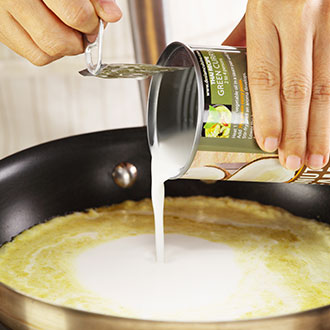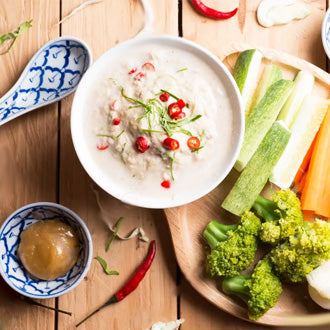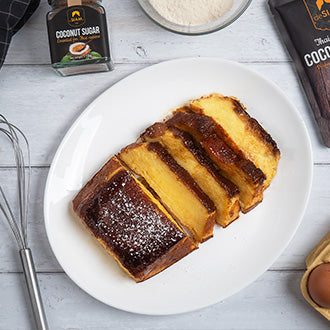My shopping cart
Your cart is currently empty.
Continue Shopping
Coconut milk is crucial in Thai cooking, you can use this ingredient in a wide range of curries, soups, dipping sauces, or desserts.
If you are not familiar with cooking Thai food, you may get confused between coconut milk, coconut cream and coconut juice or water.
They are all products from coconut fruit, but consistencies, purposes and the techniques used are all different. Generally, Thai people call coconut milk ‘Gati’ and coconut juice ‘Nam Mapraw’.
The coconut juice or water is the clear, sweet, refreshing liquid you find inside a young green coconut and normally served as a drink.
However, coconut milk and coconut cream are extracted from finely grated, mature, coconut flesh.
Only mature coconut flesh can be used as it is squeezed into a rich milk. Coconut cream and milk are made the same way, but the difference between the two is coconut cream has a higher fat content (less water and more coconut), so it is thicker and richer than coconut milk.
In Thailand, Gati is traditionally made by mixing the grated meat of a mature coconut with warm water then knead and squeeze it through a sieve lined with muslin cloth.
From the first squeeze, you will get a coconut cream which has a thick consistency like a cream and contains the most flavor and scent. It is usually called ‘the head’ or ‘Hua Gati’ in Thai.
Continue to add more water and repeat the process of kneading and squeezing it again, then you will get the ‘body’ or coconut milk which is weaker than the first one. Many Thai people still prefer to use freshly squeezed coconut milk for the reason that fresh ingredient gives a better, richer taste.
But if you can’t make it at home, a canned coconut milk is still a good substitute to give you authentic flavor and texture than using dairy products or creams. It is also convenient for cooking, save time, easy to store, and has a longer shelf-life. If you live outside Thailand, you can probably only find ‘coconut milk (body)’ which is totally fine, since most canned coconut milk is quite rich and can be used for cooking as the same method as coconut cream.
To store canned coconut milk, keep in a cool and dry place away from heat and direct sunlight. Once opened transfer into a container, keep refrigerated and use within 3 days.
There are many ways to use coconut milk in Thai food, and here are five ideas from deSIAM:

Coconut milk is a staple in Thai cuisine, mainly in curries either Massaman Curry, Panang Curry, Red or Green Curry. Both coconut cream and milk are thicker than regular dairy milk or cream and both are unsweetened and works well with spicy cooking and that is why it is commonly used for curries.
In traditional Thai cooking, the coconut cream is used in curry dishes when first heating the curry to bring out the taste and aroma. Then the coconut milk will be added in the curry later to bring to the right consistency. Learn how to use coconut milk and cook curry dishes from your deSIAM kitchen here.

Coconut milk is also a good base cooking liquid for some soups like Tom Kha Kai and Tom Yam.
Tom Kha Kai (Thai Coconut Chicken Soup) is a spicy and sour hot soup made from coconut milk, galangal, kaffir lime leaves, lemongrass, Thai chili, straw mushrooms, chicken, seasoned with fish sauce, and lime juice. In Thailand, both clear and creamy Tom Yam are very popular, depending on your taste or mood.
For traditional creamy Tom Yam, a little coconut milk will be added together with sweet Thai chili paste called ‘Nam Prik Pao’. The result is a richer and more voluptuous soup.

Another idea to use coconut milk is for cooking rice. You can simply add a few spoonsful of coconut milk, a little bit of salt, sugar to the water when cooking Jasmine rice.
You will get a fluffy, aromatic, and tastier rice which you can eat with curry, stir-fried, or any savory dishes. You can use it to make sweet coconut rice which is very popular in Thailand served as a dessert or sweet snack. It is made with glutinous rice prepared by cooking with coconut milk and sugar instead of water, before serving with fresh ripe mango or durian and top it again with the coconut cream.
Outside of the mango or durian season, it will also be eaten with other fruits or semi-sweet dishes like, ground dried fish or custard pudding. Other popular coconut rice desserts are Khao Tom Mud, which is sweet banana stuffed inside coconut sticky rice and wrapped in a banana leaf before being steamed. Khao Lam is a sweet custardy sticky rice in bamboo tube. It is made of sticky rice, black beans, sugar, salt and coconut milk mixture, which is stuffed inside a bamboo tube, then slowly roasted over coals.

Thai people also use coconut cream and milk for creating dipping sauces called ‘Lon’ (pronounced as Loan). Most Thai dips are spicy because they contain chili pastes as a base, but Lon use coconut milk as a main ingredient and does not require any chilies or chili paste in it.
In general, Lon has a mild sweet, savory, a tiny hint of spice and creamy consistency. The dish is typically served with fresh vegetables and rice. There are many types of Lon dipping sauces which vary by their ingredients. For examples, Tao Jiew Lon made from soya beans, ground pork and prawns, Lon Pla Khem made from salted fish, and Lon Pu made with crab meat.

Besides making sweet sticky rice, Thai people also use coconut milk in other traditional desserts like Gluay Buat Chee (Sweet Banana in Coconut Milk), Khanom Krok (Sweet Coconut Pudding), Khanom Tuay (Coconut Milk Custard) and even Ice cream.
There are many techniques you can use to create desserts with coconut milk. Some good examples are Gluay Buat Chee which is made from ripe banana, sugar, salt and boiled in coconut milk. The dish can be served like a soup, hot or cold and with ice cubes depending on the weather and your mood.
Tub Tim Krob is made from cubes of water chestnuts soaked in vivid grenadine syrup, rolled in tapioca flour, then boiled. It is usually served with sweet coconut milk and shaved ice or ice cubes. This dessert is so delicious and refreshing that it has been named one of the world's best 50 desserts by CNN Travel. For making Khanom Tuay and Khanom Krok, the coconut milk is added to the mixture like rice flour, sugar or banana before cooked. Khanom Tuay is typically steamed and served in small ceramic cups. While Khanom Krok is cooked in a heating mantle. Both desserts have the fragrance, sweetness and the smooth pudding texture from the coconut milk. The Thai version of coconut milk ice cream has a unique taste and aroma. The ice cream mixture usually combines coconut milk and palm sugar, then special ingredients like pandan noodles, jackfruit and coconut flesh are added and give extra chewable texture to the ice cream.
Here are just a few ideas for using coconut milk in cooking, and you can be more creative like making a whipped cream or adding it in a cocktail.
Feel inspired and want to get a can of high quality coconut milk for your next Thai meals?
Check out deSIAM products in your local stores or order from our online shop here.